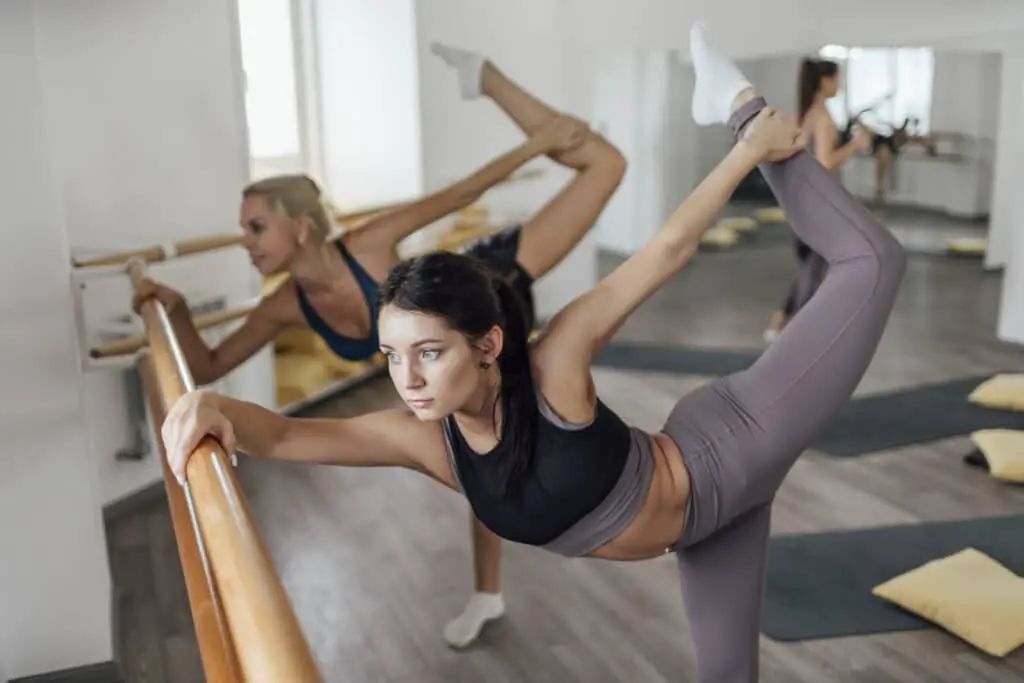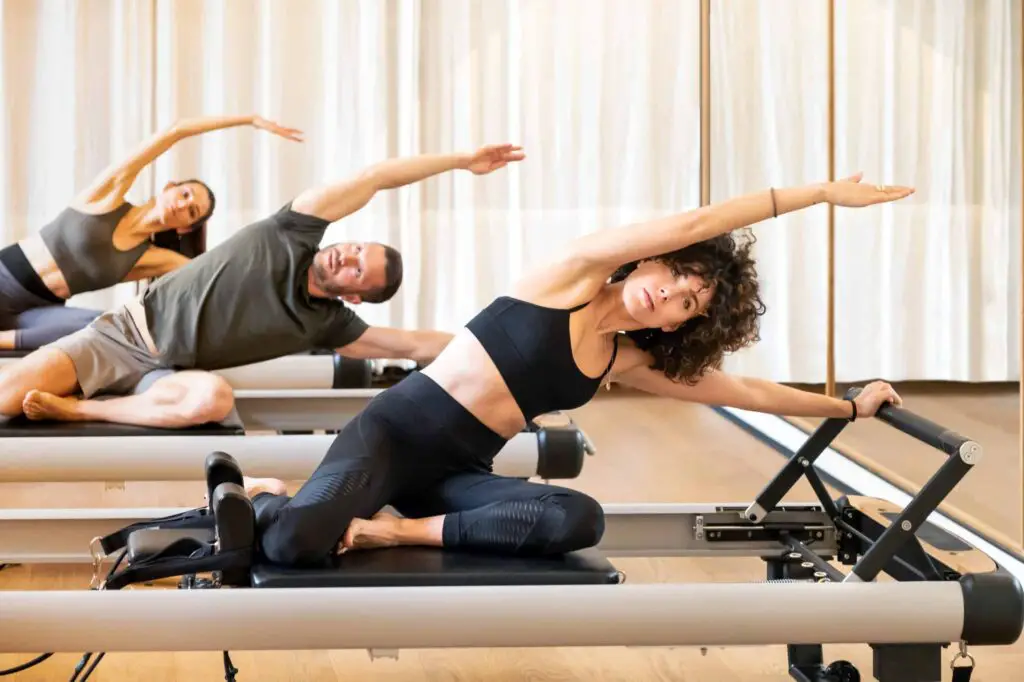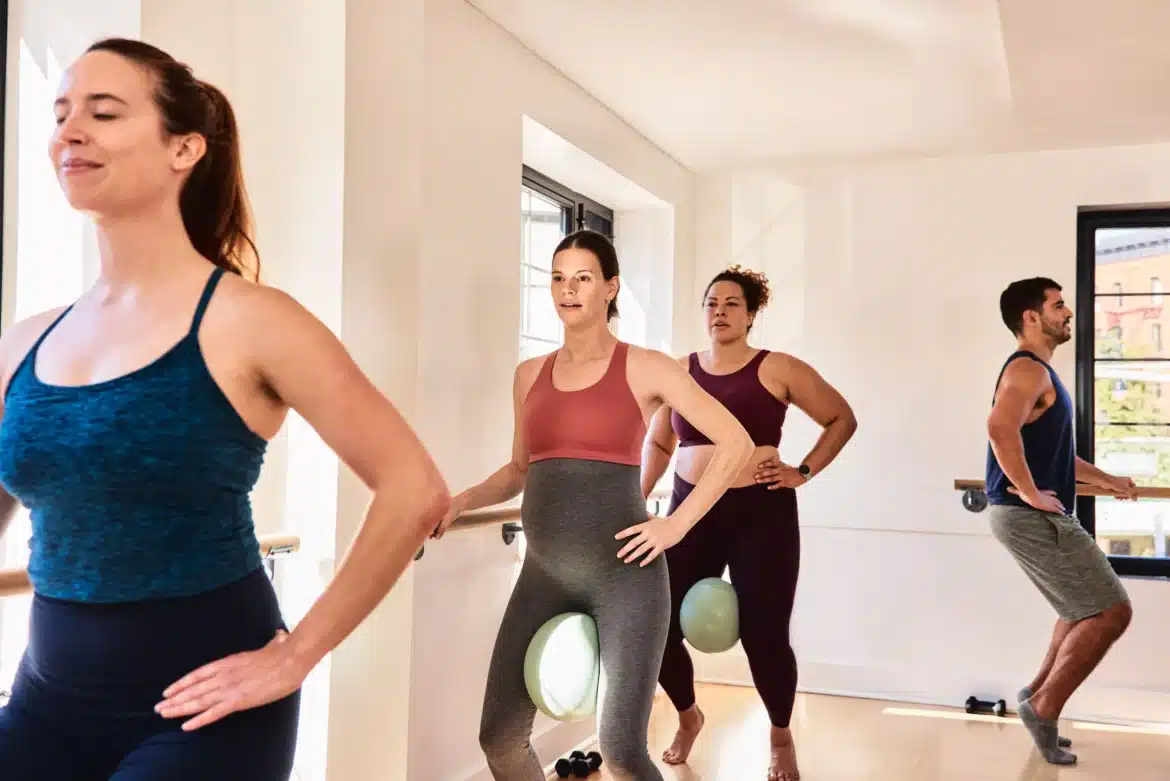Introduction
Is Barre Or Pilates Better For Toning: Barre is a ballet-inspired workout that combines elements of dance, yoga, and strength training. It incorporates the use of a ballet barre (or a sturdy chair) for support while performing a series of small, isometric movements that target specific muscle groups. These movements are designed to fatigue muscles quickly, leading to a toned and lean appearance. Barre workouts often include elements of cardio, making it an engaging option for those seeking both toning and cardiovascular benefits.
Pilates, on the other hand, is a low-impact exercise system developed by Joseph Pilates in the early 20th century. Pilates focuses on core strength, flexibility, and overall body awareness. It emphasizes controlled, precise movements that engage the deep abdominal muscles and promote better posture. Pilates can be adapted to various fitness levels and goals, making it an excellent choice for individuals looking to tone their bodies while improving core stability and flexibility.
The decision between Barre and Pilates workout ultimately boils down to personal preferences and objectives. Barre is often preferred by those who enjoy the combination of dance-inspired movements and a more dynamic, high-energy workout. It can help sculpt long, lean muscles and improve cardiovascular fitness. Conversely, Pilates is favored by individuals seeking a holistic approach to toning. It enhances overall body strength, flexibility, and balance while prioritizing core stability. Pilates can be especially beneficial for individuals with joint issues or those recovering from injuries due to its low-impact nature.

Does barre make you toned?
Barre helps strengthen and tone your muscles without increasing bulk, and it improves your posture. It also increases cardiovascular endurance and metabolism, which helps to quickly burn calories. Regular barre workouts can increase your bone density, which can help prevent conditions like osteoporosis.
Is Pilates the best workout for toning?
Muscle Definition: Barre exercises focus on major muscle groups like the legs, glutes, core, and arms. The isometric contractions and high repetitions help build lean muscle mass, leading to improved muscle definition.
Improved Posture: Barre workouts promote better posture by strengthening the muscles responsible for maintaining proper alignment. This can give the appearance of a longer, leaner body.
Core Strength: A strong core is essential for a toned physique. Barre routines include many core-strengthening exercises, helping to sculpt the abdominal muscles.
Flexibility: Enhanced flexibility from regular barre practice can lead to a more elongated appearance and greater muscle definition. Flexible muscles also recover more quickly, reducing the risk of injury.
Calorie Burn: While not primarily a cardio workout, barre can still help burn calories, aiding in overall fat loss. This, combined with muscle toning, can contribute to a leaner appearance.
Is Pilates Good For Toning Your Body?
Pilates has many benefits, one of which is body toning. Performing the Pilates exercises, you can build toned muscles without building bulk (unlike strength training).
Lean Muscle Development: Pilates promotes the development of long, lean muscles rather than bulky ones. The controlled movements and resistance exercises help create a sculpted appearance.
Core Toning: Pilates is renowned for its core-strengthening benefits. A strong core not only provides better support for the spine but also results in a flatter stomach and toned abdominal muscles.
Improved Posture: Pilates works to correct posture by strengthening the muscles that support the spine. Good posture can create the illusion of a more toned and confident presence.
Flexibility: Enhanced flexibility from regular Pilates practice contributes to a longer, leaner appearance. Supple muscles are less prone to injury and can better showcase muscle definition.
Balance and Coordination: Pilates enhances balance and coordination, which can lead to a more graceful and toned physique. Improved coordination allows for precise and controlled movements, further accentuating muscle engagement.
Will barre tone my thighs?
When people start doing barre workouts consistently, they often (happily) notice a change in their thighs (and the rest of their body), which makes sense, since the movements challenge you in totally new ways. But potentially slimmer thighs aren’t the only benefit of this sculpting powerhouse of a workout.
Muscle Engagement: Barre exercises, especially those involving leg lifts, leg extensions, and pliés, engage the quadriceps, hamstrings, and inner and outer thigh muscles. Consistent engagement of these muscle groups can help tone and define the thighs.
Isometric Contractions: Barre emphasizes isometric contractions, which involve holding positions that target specific muscle groups. These contractions help strengthen and sculpt the thigh muscles without adding bulk.
Lunges and Leg Lifts: Many barre exercises involve lunges, leg lifts, and small pulsing movements. These movements isolate and target the thighs, helping to build lean muscle mass.
Flexibility and Lengthening: Barre workouts often include stretching and lengthening exercises that can help elongate the thigh muscles. This can create a more toned and streamlined appearance.
Improved Circulation: The emphasis on controlled movements and deep muscle engagement in barre can promote better blood circulation to the thighs, potentially aiding in reducing the appearance of cellulite.
Can I get toned from Pilates alone?
Pilates can most certainly tone your body. However, toning your body doesn’t mean what you might think it means. By definition, Tone means to give greater strength or firmness to (the body or a muscle). So, simple answer to the question is yes, Pilates can tone your body.
Muscle Toning: Pilates exercises target multiple muscle groups, including the core, arms, legs, and back. The controlled movements and resistance used in Pilates can help build lean muscle mass, leading to a more toned physique.
Core Strengthening: A strong core is essential for achieving a toned look, especially around the midsection. Pilates is renowned for its core-strengthening benefits, which can result in a flatter stomach and toned abdominal muscles.
Muscle Lengthening: Pilates includes stretches and elongation exercises that promote muscle lengthening. Longer muscles tend to appear more toned and sculpted.
Improved Posture: Pilates workouts emphasize proper alignment and body awareness, leading to improved posture. Good posture can create the illusion of a taller, leaner, and more toned body.
Balance and Coordination: Pilates enhances balance and coordination, which can lead to a more graceful and toned appearance. Enhanced coordination allows for precise and controlled movements, further accentuating muscle engagement.
Does Pilates tone your thighs?
Pilates is a great low impact, easy-on-the-knees way to tone and shape the lower body, particularly the butt and thighs. We love Pilates for recovery days, and workout sessions where you just don’t feel like pushing yourself through a jarring HIIT workout, or grueling strength session.
Muscle Engagement: Pilates exercises often engage the quadriceps (front thigh muscles), hamstrings (back thigh muscles), and inner thigh muscles. Movements like leg lifts, lunges, and squats can target and tone these muscle groups effectively.
Isometric Contractions: Pilates emphasizes isometric contractions, which involve holding positions that target specific muscle groups without the need for weights or resistance bands. These contractions help sculpt and strengthen the thigh muscles.
Lengthening and Sculpting: Pilates exercises promote muscle lengthening, leading to a more elongated and toned appearance in the thighs. The continuous focus on controlled movements and proper alignment contributes to sculpting the muscles.
Improved Circulation: Pilates workouts enhance blood circulation to the thigh area due to the emphasis on precise movements and deep muscle engagement. This can aid in reducing the appearance of cellulite and promote overall thigh toning.
Balance and Stability: Pilates enhances balance and stability, which can lead to more graceful and toned-looking thighs. Improved balance allows for precise and controlled movements, emphasizing muscle engagement.
How often should I do Pilates to get toned?
We recommend that you participate in Pilates classes (private or group) 2-3 times a week and normally, you should begin to feel the benefits of Pilates (i.e. more flexibility, improved balance and strengthening) within 2 – 3 weeks.
Beginners: If you’re new to Pilates, starting with 2 to 3 sessions per week is a good foundation. This allows you to build strength, improve flexibility, and adapt to the practice gradually.
Intermediate Practitioners: Those with some Pilates experience can aim for 3 to 4 sessions per week. This frequency allows for more consistent progress in muscle toning and flexibility.
Advanced Practitioners: Advanced Pilates enthusiasts, or those with specific toning goals, may practice 4 to 6 times a week. However, it’s crucial to incorporate variation in intensity and exercises to prevent overtraining.
Balanced Approach: Combining Pilates with other forms of exercise, such as cardiovascular workouts and strength training, can provide a more holistic approach to toning. In this case, 2 to 4 Pilates sessions per week, along with other activities, can yield excellent results.
Rest Days: Regardless of your level, to incorporate rest days into your weekly routine. Rest is essential for muscle recovery and preventing burnout. At least one or two rest days per week are recommended.
What is the fastest way to tone your thighs?
Squats. Squats are one of the best exercises to tone the thighs because they target the quads, hamstrings, and glutes, as well as the core. Plus, there are lots of different types of squats, making it easy to switch up your routine and keep your muscles challenged and growing.
Cardiovascular Exercise
Incorporating cardiovascular workouts into your routine can help reduce excess body fat and reveal the toned muscles underneath. While you can’t spot-reduce fat from your thighs, regular cardio exercises like running, cycling, or swimming can contribute to overall fat loss, including in the thigh area. Aim for at least 150 minutes of moderate-intensity cardio per week.
High-Intensity Interval Training (HIIT)
HIIT workouts are known for their ability to burn calories and boost metabolism. They combine short bursts of intense exercise with brief periods of rest or lower intensity. HIIT can be particularly effective for fat loss, including in the thighs. Incorporate exercises like squat jumps, burpees, or sprint intervals into your routine.
Pilates
Pilates is excellent for both toning and lengthening the muscles. It focuses on strengthening the core and lower body muscles, including the thighs. Regular Pilates sessions can help create leaner and more sculpted thigh muscles.
Healthy Eating Habits
A balanced and nutritious diet plays a crucial role in toning your thighs. Aim to consume a variety of nutrient-dense foods, including lean proteins, whole grains, fruits, vegetables, and healthy fats. This will provide your body with the energy it needs for workouts and support muscle growth while helping you maintain a healthy weight.
Why are thighs so hard to tone?
First and foremost, your genetics play a role in firming up your thighs. Unfortunately, some women are just born with more fat cells and fewer muscle cells, says Wayne Westcott, Ph. D., director of exercise research at Quincy College.
Genetics
Genetics play a significant role in determining the distribution of fat and muscle in your body. Some people may naturally store more fat in their thigh area, making it more challenging to achieve a toned look. Genetics can also influence the shape and size of your thigh muscles, which can affect how they respond to exercise.
Gender Differences
Men and women tend to store fat differently, with women often storing more fat in the thigh and hip area due to hormonal factors. Men typically have a higher percentage of muscle mass, which can make it easier for them to tone their thighs compared to women.
Hormones
Hormonal fluctuations, particularly in women, can affect fat storage and muscle development in the thigh area. Hormonal changes during the menstrual cycle, pregnancy, or menopause can impact the ease with which thigh fat is lost and muscle tone is gained.
Lack of Targeted Exercises
Thighs are composed of several muscle groups, including the quadriceps, hamstrings, adductors, and abductors. To effectively tone the thighs, it’s crucial to engage all of these muscle groups with targeted exercises. A lack of comprehensive thigh workouts can hinder progress.
Resistance to Fat Loss
The fat stored in the thighs can be stubborn and resistant to fat loss, especially for those who have a genetic predisposition to store fat in this area. Achieving a lower body fat percentage, which is essential for visible muscle definition, can be more challenging for some individuals.

Conclusion
Pilates places a strong emphasis on core strength, flexibility, and overall body awareness. It excels in improving posture and cultivating a balanced physique. Pilates’ low-impact nature makes it accessible to a wide range of individuals, including those recovering from injuries or dealing with joint concerns. It provides a comprehensive approach to toning by targeting not only specific muscle groups but also overall body alignment.
The effectiveness of Barre or Pilates for toning depends on one’s fitness objectives. If you’re looking for a high-energy workout that combines strength training and dance elements, Barre might be your preferred choice. On the other hand, if you prioritize core strength, flexibility, and injury prevention, Pilates is an excellent option. To recognize that these modalities are not mutually exclusive. Many fitness enthusiasts find value in incorporating both Barre and Pilates into their routines, taking advantage of the unique benefits each offers. Variety can prevent workout plateaus and provide a well-rounded approach to fitness.
The decision between Barre and Pilates for toning is a matter of personal preference and fitness goals. Both modalities have their strengths, and both can be effective in achieving a toned and fit body. To make the most of your fitness journey, consider trying both and consulting with a fitness professional to create a balanced workout regimen tailored to your specific needs and aspirations. Ultimately, whether you choose Barre, Pilates, or a combination of both, your dedication and consistency in practice will play the most significant role in achieving your toning goals.

